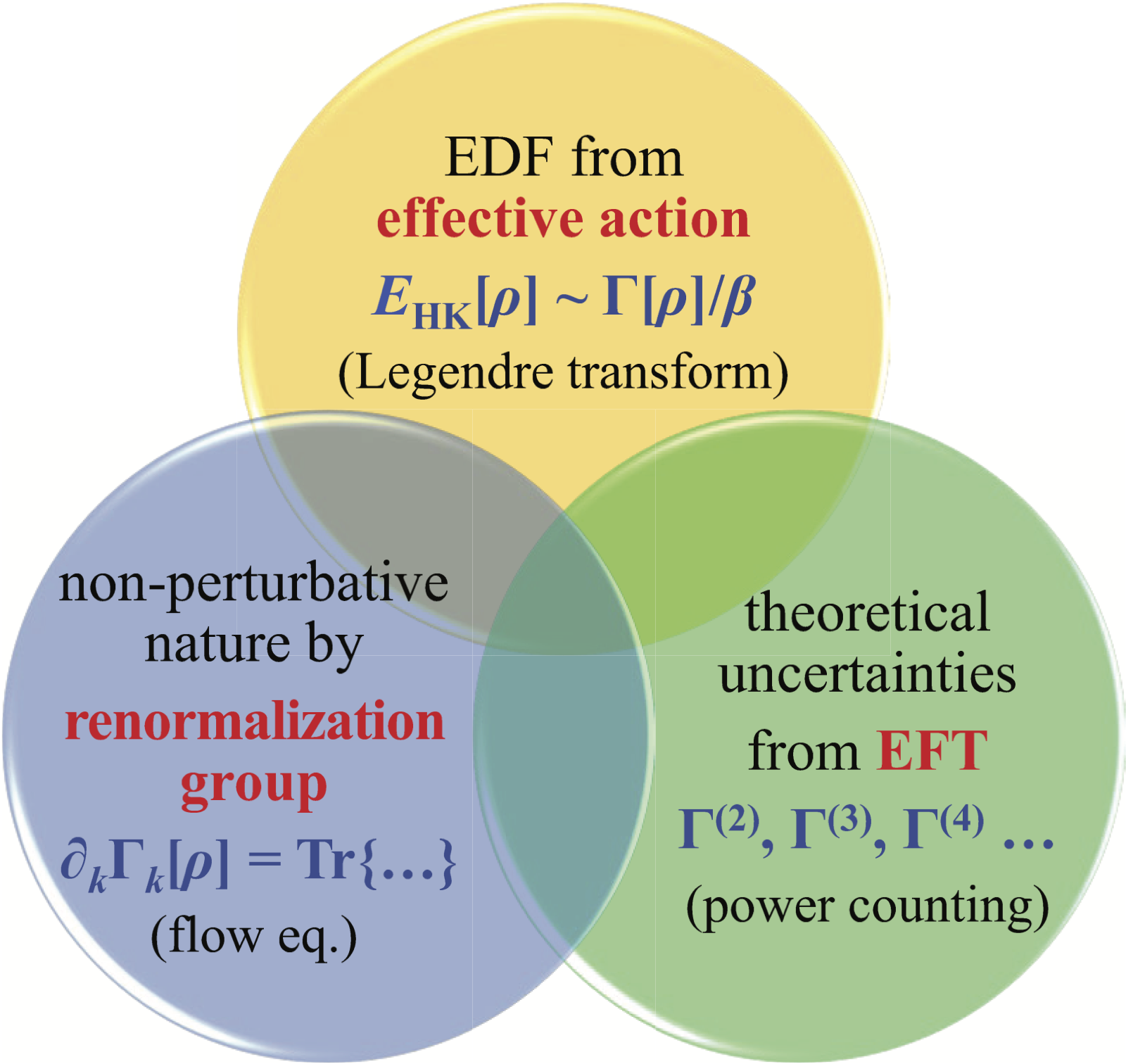Research Topics
Research Background
Atomic nuclei, composed of protons and neutrons, represent one fundamental hierarchy of matter. As famous for Nihonium (Element 113), Japan is one of the world-leading countries in nuclear physics. Questions like
- How many different kinds of nuclei exist in the Universe?
- Where and how are they created?
- How can human being make the best and safe use of nuclei?
Theoretical studies in nuclear physics are not trivial at all, because each atomic nucleus is a quantum system, a many-body system, a finite system, as well as an open system. In addition, in atomic nuclei, three fundamental interactions out of four—the strong, weak, and electromagnetic interactions—interplay each other in a large range of time and energy scales with the co-existence of single-particle and collective characteristics.
Because of these unique features, although microscopic nuclear theories could be traced back to, e.g., the Nobel Prize work of Yukawa, there still exist tons of open questions in this field.
Recent Research Themes
General Ideas
In particular, during the past decades, thanks to the significant progress in quantum many-body theories and the worldwide exponential increase of computational powers, microscopic nuclear theories are gradually established, including the ab initio approach, cluster method, shell model, density functional theory (DFT), and so on.
The main research theme in our group is nuclear DFT, which aims at understanding both ground-state and excited-state properties of thousands of nuclei in a consistent and predictive way. Among the microscopic nuclear theories, now, even in the visible future, only DFT is applicable to almost the whole nuclear chart.
Research themes in the recent 3 years
- Microscopic foundation of nuclear DFT
- Functional Renormalization Group and DFT
- T. Yokota and T. Naito. Phys. Rev. B 105, 035105 (2022)
- T. Yokota and T. Naito. Phys. Rev. Research 3, L012015 (2021)
- T. Yokota and T. Naito. Phys. Rev. B 99, 115106 (2019)
- H.Z. Liang, Y.F. Niu, and T. Hatsuda. Phys. Lett. B 779, 436 (2018)
- Inverse Kohn-Sham method and density functional perturbation theory
- G. Accorto, T. Naito, H.Z. Liang, T. Nikšić, and D. Vretenar. Phys. Rev. C 103, 044304 (2021)
- T. Naito, D. Ohashi, and H.Z. Liang. J. Phys. B 52, 245003 (2019)
- Nucleon finite-size effects on nuclear binding
- T. Naito, X. Roca-Maza, G. Colò, and H.Z. Liang. Phys. Rev. C 101, 064311 (2020)
- T. Naito, X. Roca-Maza, G. Colò, and H.Z. Liang. Phys. Rev. C 99, 024309 (2019)
- T. Naito, R. Akashi, and H.Z. Liang. Phys. Rev. C 97, 044319 (2019)
- The connection between the relativistic and non-relativistic density functional theories
- Y.X. Guo and H.Z. Liang. Phys. Rev. C 101, 024304 (2020)
- Y.X. Guo and H.Z. Liang. Chin. Phys. C 43, 114105 (2019)
- Y.X. Guo and H.Z. Liang. Phys. Rev. C 99, 054324 (2019)
- Relativistic ab initio calculations for finite nuclei
- S.H. Shen, H.Z. Liang, W.H. Long, J. Meng, and P. Ring. Prog. Part. Nucl. Phys. 109, 103713 (2019)
- S.H. Shen, H.Z. Liang, J. Meng, P. Ring, and S.Q. Zhang. Phys. Rev. C 97, 054312 (2018)
- S.H. Shen, H.Z. Liang, J. Meng, P. Ring, and S.Q. Zhang. Phys. Lett. B 781, 227 (2018)
- S.H. Shen, H.Z. Liang, J. Meng, P. Ring, and S.Q. Zhang. Phys. Lett. B 778, 344 (2018)
- S.H. Shen, H.Z. Liang, J. Meng, P. Ring, and S.Q. Zhang. Phys. Rev. C 96, 014316 (2017)
- S.H. Shen, J.N. Hu, H.Z. Liang, J. Meng, P. Ring, and S.Q. Zhang. Chin. Phys. Lett. 33, 102103 (2016)
- Consistent nuclear database for astrophysical nucleosynthesis study
- Nuclear mass and \( \beta \)-decay half-life predictions with Bayesian approaches
- Z.M. Niu, H.Z. Liang, B.H. Sun, W.H. Long, and Y.F. Niu. Phys. Rev. C 99, 064307 (2019)
- Z.M. Niu, H.Z. Liang, B.H. Sun, Y.F. Niu, J.Y. Guo, and J. Meng. Sci. Bulletin 63, 759 (2018)
- Z.M. Niu and H.Z. Liang. Phys. Lett. B 778, 48 (2018)
- Influence of nuclear mass uncertainties on radiative neutron-capture rates
For more detailed information, please see the publication list.
Future perspectives
A mid-term goal: Ab initio nuclear DFT
One of our goals in the coming years is to develop an ab initio nuclear DFT, starting from realistic nuclear force. Oriented by quantum field theory (QFT), our ideas include
- the energy density functional will be derived from the effective action with Legendre transform
- the non-perturbative nature of nuclear force will be handle by the renormalization group with flow equations
- the theoretical uncertainties will come with the idea of effective field theory with proper power counting

A long-term dream: Microscopic understanding of quantum many-body tunneling
Nuclear fission and fusion, which critically depend on the properties of quantum many-body tunneling, are still among the most long-standing and most challenging problems in nuclear physics. The relevant studies are crucial not only for nuclear physics but also for the element cycling in astrophysical nucleosynthesis, the treatment of long-lived fission products by nuclear power plants.
Will modern QFT help? Will machine learning and quantum computing help? These are questions for young students with dreams.
